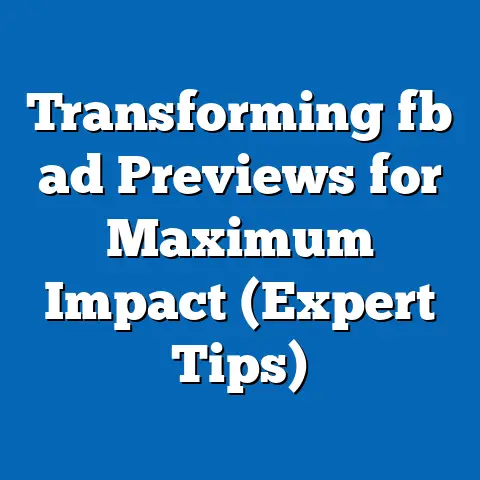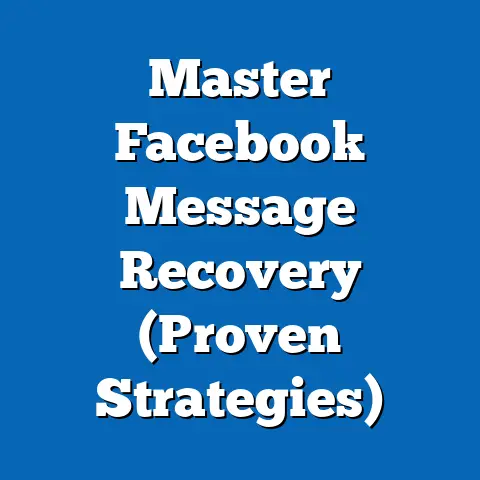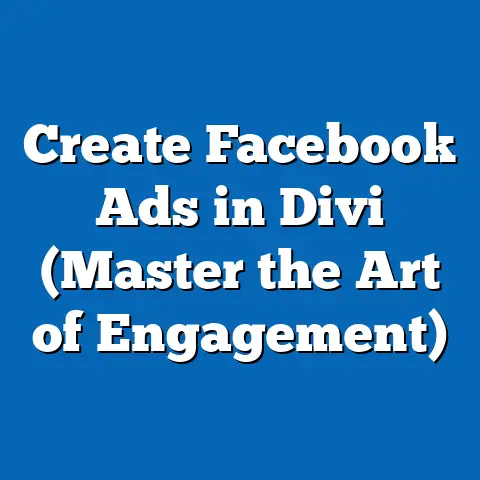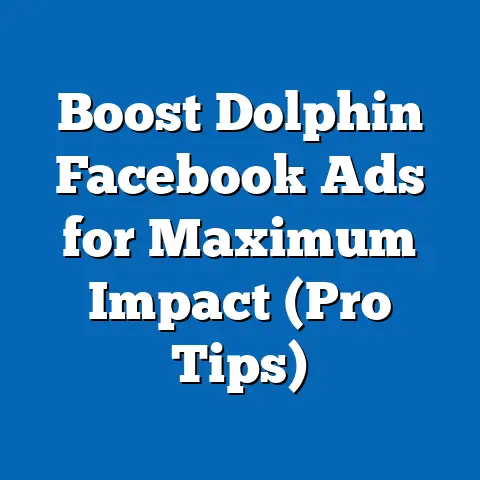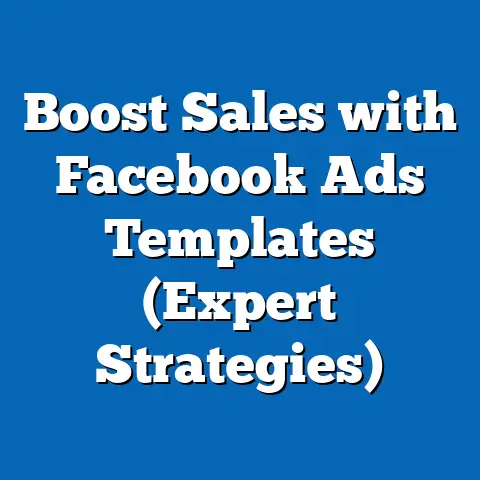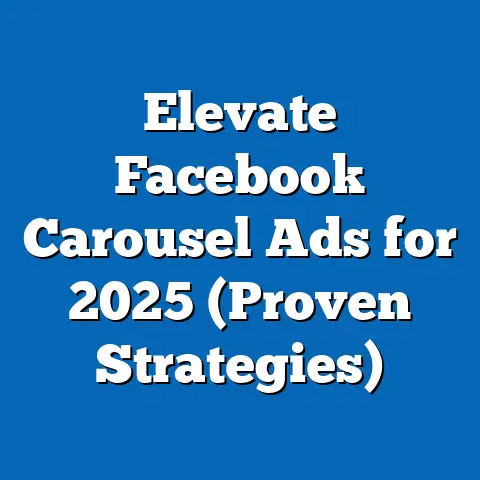Optimal Video Format for Facebook Ads (Pro Marketing Strategies)
Before we jump in, I want to tell you a quick story. A few years back, I was working with a local bakery struggling to get their name out there. They had beautiful products, but their Facebook page was…well, let’s just say it wasn’t winning any awards. We started experimenting with video ads, and initially, the results were underwhelming. The videos were blurry, the aspect ratio was off, and frankly, they looked unprofessional. It was like they’d renovated their storefront with mismatched tiles and crooked shelves – the potential was there, but the execution was a mess.
That’s when I realized the importance of nailing the video format. We meticulously adjusted dimensions, optimized file sizes, and even invested in better lighting. The transformation was incredible! Suddenly, their delicious treats were popping off the screen, drawing in customers like never before. Just like a well-executed renovation can breathe new life into a space, optimizing their video format breathed new life into their Facebook advertising.
So, let’s get started and make sure your video ads are as irresistible as a freshly baked croissant.
The Importance of Video in Advertising
Video isn’t just a trend; it’s the dominant force in digital marketing. Think about your own online behavior. How often do you scroll past text-heavy posts and stop to watch a short video? I know I do it all the time!
Here’s why video is so crucial:
- Attention-grabbing: In a sea of content, video stands out. The movement and visual stimulation naturally draw the eye.
- Engaging: Video allows you to tell a story, showcase your product in action, and connect with your audience on an emotional level.
- Informative: You can convey a lot of information in a short amount of time. Think about explainer videos, product demos, or even quick tips.
- Shareable: Compelling videos are more likely to be shared, extending your reach organically.
- Higher Conversion Rates: Studies consistently show that video ads lead to higher click-through rates (CTR) and conversion rates compared to static images or text.
Let’s look at some stats:
- According to HubSpot, video marketers get 66% more qualified leads per year.
- Animoto reports that 93% of marketers say video is an important part of their marketing strategy.
- Wyzowl states that 87% of marketers say video has increased traffic to their website.
These numbers speak for themselves. If you’re not using video in your Facebook advertising, you’re leaving money on the table.
The Psychological Impact:
Video taps into our innate desire for storytelling. Humans are wired to connect with narratives, and video provides a powerful medium to create and share those stories. The combination of visuals, sound, and motion triggers emotions and creates a more memorable experience than static content. This emotional connection leads to better brand recall and increased purchase intent.
Takeaway: Video is no longer optional; it’s essential. Incorporating video into your Facebook advertising strategy is crucial for grabbing attention, engaging your audience, and driving results.
Understanding Facebook’s Video Specifications
Okay, now let’s get down to the nitty-gritty. Creating a great video is only half the battle. You also need to make sure it’s optimized for Facebook’s platform. This means understanding the specific dimensions, file formats, and length recommendations. Think of it like building a house – you need a solid foundation before you can start decorating.
Optimal Video Dimensions (Aspect Ratios, Resolution):
This is where a lot of people stumble. Facebook supports various aspect ratios and resolutions, depending on the ad placement. Here’s a breakdown:
-
Feed Ads:
- Recommended Aspect Ratio: 1:1 (square), 4:5 (vertical), or 16:9 (horizontal).
- Recommended Resolution: 1080 x 1080 pixels (for square), 1080 x 1350 pixels (for vertical), and 1920 x 1080 pixels (for horizontal).
- Why? Square and vertical videos take up more screen real estate on mobile devices, which is where most Facebook users are. Horizontal videos are better suited for desktop viewing.
-
Stories Ads:
- Recommended Aspect Ratio: 9:16 (full-screen vertical).
- Recommended Resolution: 1080 x 1920 pixels.
- Why? Stories are designed for mobile viewing, so full-screen vertical videos provide the most immersive experience.
-
In-Stream Ads:
- Recommended Aspect Ratio: 16:9 (horizontal).
- Recommended Resolution: 1920 x 1080 pixels.
- Why? In-stream ads play within other videos, so a horizontal format is the standard.
-
Instant Articles:
- Recommended Aspect Ratio: 1:1, 4:5, or 16:9.
- Recommended Resolution: Varies depending on the aspect ratio (same as Feed Ads).
- Why? Instant Articles are designed to load quickly on mobile devices, so optimizing for different aspect ratios ensures compatibility.
Feed Ads:
- Recommended Aspect Ratio: 1:1 (square), 4:5 (vertical), or 16:9 (horizontal).
- Recommended Resolution: 1080 x 1080 pixels (for square), 1080 x 1350 pixels (for vertical), and 1920 x 1080 pixels (for horizontal).
- Why? Square and vertical videos take up more screen real estate on mobile devices, which is where most Facebook users are. Horizontal videos are better suited for desktop viewing.
Stories Ads:
- Recommended Aspect Ratio: 9:16 (full-screen vertical).
- Recommended Resolution: 1080 x 1920 pixels.
- Why? Stories are designed for mobile viewing, so full-screen vertical videos provide the most immersive experience.
In-Stream Ads:
- Recommended Aspect Ratio: 16:9 (horizontal).
- Recommended Resolution: 1920 x 1080 pixels.
- Why? In-stream ads play within other videos, so a horizontal format is the standard.
Instant Articles:
- Recommended Aspect Ratio: 1:1, 4:5, or 16:9.
- Recommended Resolution: Varies depending on the aspect ratio (same as Feed Ads).
- Why? Instant Articles are designed to load quickly on mobile devices, so optimizing for different aspect ratios ensures compatibility.
File Formats Supported by Facebook (MP4, MOV, etc.):
Facebook supports a wide range of video file formats, but MP4 and MOV are the most common and recommended. Here’s why:
- MP4: Widely supported, offers good compression, and maintains decent video quality.
- MOV: Developed by Apple, also offers good quality and compatibility.
Other supported formats include:
- 3GPP
- AVI
- FLV
- MKV
- WebM
- WMV
Pro Tip: Stick to MP4 or MOV for the best results. They’re universally compatible and generally provide the best balance of quality and file size.
Video Length Recommendations for Different Ad Placements (Feed, Stories, etc.):
Video length is another crucial factor. Attention spans are short, so you need to grab your audience quickly and keep them engaged.
-
Feed Ads:
- Recommended Length: 15 seconds or less.
- Why? Shorter videos are more likely to be watched in their entirety, leading to better engagement and completion rates.
-
Stories Ads:
- Maximum Length: 15 seconds per story.
- Why? Stories are designed for quick, bite-sized content.
-
In-Stream Ads:
- Recommended Length: 15-30 seconds.
- Why? In-stream ads have a slightly longer window to capture attention, but you still need to be concise.
-
Longer Videos:
- When to Use: If you have a compelling story to tell or a complex product to demonstrate, you can use longer videos (up to several minutes). However, make sure the first few seconds are captivating to keep viewers hooked.
Feed Ads:
- Recommended Length: 15 seconds or less.
- Why? Shorter videos are more likely to be watched in their entirety, leading to better engagement and completion rates.
Stories Ads:
- Maximum Length: 15 seconds per story.
- Why? Stories are designed for quick, bite-sized content.
In-Stream Ads:
- Recommended Length: 15-30 seconds.
- Why? In-stream ads have a slightly longer window to capture attention, but you still need to be concise.
Longer Videos:
- When to Use: If you have a compelling story to tell or a complex product to demonstrate, you can use longer videos (up to several minutes). However, make sure the first few seconds are captivating to keep viewers hooked.
The Importance of Subtitles and Captions for Accessibility and Engagement:
This is non-negotiable. Adding subtitles and captions to your video ads is crucial for several reasons:
- Accessibility: Many people watch videos with the sound off, especially in public places. Subtitles ensure that everyone can understand your message.
- Engagement: Subtitles can help viewers stay engaged, even if they’re not actively listening.
- SEO: Facebook can index the text in your subtitles, improving your ad’s visibility in search results.
- Compliance: In some regions, providing captions is legally required for accessibility.
Pro Tip: You can add subtitles manually in Facebook Ads Manager, or you can use third-party tools to automatically generate them.
Takeaway: Understanding and adhering to Facebook’s video specifications is essential for creating ads that look professional, perform well, and reach a wider audience. Don’t skip this step!
Crafting Compelling Video Content
Now that you know the technical specs, let’s talk about the creative side. Content is king, and a compelling video is worth its weight in gold. This is where you get to tell your story, showcase your brand, and connect with your audience on an emotional level.
Creating a Narrative that Resonates with the Target Audience:
Think about your ideal customer. What are their pain points? What are their aspirations? What kind of content do they enjoy? Your video should address these questions and offer a solution or a source of inspiration.
Here’s how to create a resonant narrative:
- Identify Your Target Audience: Understand their demographics, interests, and behaviors.
- Define Your Message: What do you want your audience to take away from the video?
- Craft a Story: Use storytelling techniques to make your message more engaging and memorable.
- Show, Don’t Tell: Use visuals to demonstrate the benefits of your product or service.
- Keep it Authentic: Be genuine and relatable. People can spot a fake a mile away.
The Importance of Strong Hooks in the First Few Seconds to Capture Attention:
You have about 3 seconds to grab someone’s attention on Facebook. That’s it! If your video doesn’t hook them in those first few seconds, they’re going to keep scrolling.
Here are some ideas for creating a strong hook:
- Ask a Question: Pose a question that addresses your audience’s pain points or interests.
- Make a Bold Statement: Start with a surprising or intriguing statement.
- Show a Problem: Visually demonstrate a problem that your product or service solves.
- Create Curiosity: Tease something exciting or mysterious.
- Use Humor: If appropriate for your brand, a funny opening can be very effective.
The Use of Visuals, Branding, and Color Psychology to Enhance Viewer Interest:
Visuals are just as important as the narrative. Use high-quality footage, eye-catching graphics, and consistent branding to create a visually appealing video.
Here are some tips:
- Use High-Resolution Footage: Avoid blurry or pixelated videos.
- Incorporate Branding: Include your logo, colors, and fonts to reinforce brand recognition.
- Use Color Psychology: Choose colors that evoke the emotions you want to convey. For example, blue can convey trust and security, while red can convey excitement and energy.
- Add Motion Graphics: Use animated text, transitions, and special effects to keep viewers engaged.
- Keep it Simple: Avoid cluttering the screen with too much information.
Takeaway: Compelling video content is all about creating a narrative that resonates with your audience, grabbing their attention quickly, and using visuals to enhance their experience.
The Role of Thumbnails and Titles
Don’t underestimate the power of thumbnails and titles! These are the first things people see when they encounter your video ad, and they can make or break your click-through rate. Think of them as the book cover and title that entice you to pick up a new read.
Your thumbnail is your video’s first impression. It should be visually appealing, relevant to the content, and enticing enough to make people want to click.
Here are some tips for choosing an impactful thumbnail:
Your title and description should work together to tell people what your video is about and why they should watch it.
Here are some tips for writing captivating titles and descriptions:
Leveraging Facebook’s Ad Tools and Features
Facebook Ads Manager is your command center for creating, managing, and optimizing your video ads. It’s packed with features that can help you target the right audience, track your performance, and improve your results. I still remember the first time I used it – it was overwhelming at first, but once I learned the ropes, it became an invaluable tool.
An Overview of Facebook’s Ad Manager and How to Optimize Video Ads Using Its Features:
Here’s a quick overview of some key features in Facebook Ads Manager:
- Campaign Objectives: Choose the right objective for your campaign (e.g., brand awareness, reach, traffic, engagement, video views, lead generation, conversions).
- Audience Targeting: Target your ideal customer based on demographics, interests, behaviors, and more.
- Ad Placements: Choose where you want your ads to appear (e.g., Facebook Feed, Stories, Instagram Feed, Audience Network).
- Budget and Schedule: Set your daily or lifetime budget and schedule your ads to run at specific times.
- Ad Creative: Upload your video, write your title and description, and choose your call-to-action button.
- A/B Testing: Test different versions of your ads to see which ones perform best.
- Reporting: Track your performance metrics and analyze your results.
Using A/B Testing for Video Creatives and Analyzing Performance Metrics:
A/B testing is a powerful tool for optimizing your video ads. It allows you to test different versions of your ads to see which ones perform best.
Here are some things you can test:
- Thumbnails: Test different thumbnail images to see which ones attract the most clicks.
- Titles: Test different titles to see which ones are most compelling.
- Descriptions: Test different descriptions to see which ones generate the most engagement.
- Call-to-Action Buttons: Test different call-to-action buttons to see which ones drive the most conversions.
- Targeting: Test different targeting options to see which audiences are most responsive.
Analyzing Performance Metrics:
It’s crucial to track your performance metrics to see how your video ads are performing. Here are some key metrics to watch:
- Video Views: The number of times your video has been viewed.
- Video Completion Rate: The percentage of people who watched your video to the end.
- Click-Through Rate (CTR): The percentage of people who clicked on your ad.
- Conversion Rate: The percentage of people who completed a desired action (e.g., made a purchase, filled out a form).
- Cost Per Click (CPC): The amount you pay each time someone clicks on your ad.
- Cost Per Acquisition (CPA): The amount you pay for each conversion.
- Return on Ad Spend (ROAS): The amount of revenue you generate for every dollar you spend on advertising.
Retargeting Strategies to Keep Viewers Engaged with Additional Video Content:
Retargeting is a powerful strategy for keeping viewers engaged with your video content. It allows you to show ads to people who have already interacted with your videos.
Here are some retargeting strategies you can use:
- Target Viewers Who Watched a Certain Percentage of Your Video: Show ads to people who watched at least 25%, 50%, 75%, or 95% of your video.
- Target Viewers Who Visited Your Website: Show ads to people who visited your website after watching your video.
- Target Viewers Who Engaged with Your Facebook Page: Show ads to people who liked, commented on, or shared your video.
- Create Lookalike Audiences: Use Facebook’s lookalike audience feature to find people who are similar to your existing customers or video viewers.
Takeaway: Facebook Ads Manager is a powerful tool for optimizing your video ads. Use A/B testing to experiment with different creatives and targeting options, and track your performance metrics to see what’s working and what’s not. Don’t forget to use retargeting to keep viewers engaged with your content.
Case Studies of Successful Video Ads
Let’s take a look at some real-world examples of brands that have nailed their video ads on Facebook. Analyzing successful campaigns can provide valuable insights and inspiration for your own efforts.
Case Study 1: Dollar Shave Club
- Ad Format: Explainer Video
- Description: Dollar Shave Club’s original video ad went viral for its humorous and relatable approach to selling razors. The video featured the company’s founder, Michael Dubin, showcasing the benefits of their subscription service with witty commentary and unconventional visuals.
- Key Success Factors:
- Humor: The video was genuinely funny and entertaining.
- Relatability: The video addressed a common problem (expensive razors) in a relatable way.
- Simplicity: The video clearly explained the benefits of the subscription service.
- Authenticity: Michael Dubin’s personality shined through, making the video feel genuine.
- Lessons Learned:
- Don’t be afraid to use humor to connect with your audience.
- Focus on solving a problem in a relatable way.
- Keep your message simple and easy to understand.
- Let your brand’s personality shine through.
- Humor: The video was genuinely funny and entertaining.
- Relatability: The video addressed a common problem (expensive razors) in a relatable way.
- Simplicity: The video clearly explained the benefits of the subscription service.
- Authenticity: Michael Dubin’s personality shined through, making the video feel genuine.
- Don’t be afraid to use humor to connect with your audience.
- Focus on solving a problem in a relatable way.
- Keep your message simple and easy to understand.
- Let your brand’s personality shine through.
Case Study 2: Airbnb
- Ad Format: Storytelling Video
- Description: Airbnb often uses video ads to tell stories about their hosts and guests. These videos showcase the unique experiences that Airbnb offers and highlight the human connection that is at the heart of their brand.
- Key Success Factors:
- Emotional Connection: The videos create an emotional connection with viewers by showcasing real people and their experiences.
- Authenticity: The videos feel genuine and unscripted.
- Visual Appeal: The videos feature beautiful locations and stunning visuals.
- Inspiration: The videos inspire viewers to travel and explore new places.
- Lessons Learned:
- Use storytelling to connect with your audience on an emotional level.
- Focus on showcasing real people and their experiences.
- Use high-quality visuals to capture attention.
- Inspire your audience to take action.
- Emotional Connection: The videos create an emotional connection with viewers by showcasing real people and their experiences.
- Authenticity: The videos feel genuine and unscripted.
- Visual Appeal: The videos feature beautiful locations and stunning visuals.
- Inspiration: The videos inspire viewers to travel and explore new places.
- Use storytelling to connect with your audience on an emotional level.
- Focus on showcasing real people and their experiences.
- Use high-quality visuals to capture attention.
- Inspire your audience to take action.
Case Study 3: GoPro
- Ad Format: User-Generated Content
- Description: GoPro’s video ads often feature user-generated content, showcasing the incredible adventures that people are having with their cameras.
- Key Success Factors:
- Authenticity: The videos feel genuine and unscripted.
- Visual Appeal: The videos feature stunning footage of extreme sports and outdoor adventures.
- Inspiration: The videos inspire viewers to go out and explore the world.
- Social Proof: The videos provide social proof that GoPro cameras are durable and versatile.
- Lessons Learned:
- Leverage user-generated content to create authentic and engaging video ads.
- Focus on showcasing the experiences that your product enables.
- Use high-quality visuals to capture attention.
- Provide social proof that your product is reliable and effective.
- Authenticity: The videos feel genuine and unscripted.
- Visual Appeal: The videos feature stunning footage of extreme sports and outdoor adventures.
- Inspiration: The videos inspire viewers to go out and explore the world.
- Social Proof: The videos provide social proof that GoPro cameras are durable and versatile.
- Leverage user-generated content to create authentic and engaging video ads.
- Focus on showcasing the experiences that your product enables.
- Use high-quality visuals to capture attention.
- Provide social proof that your product is reliable and effective.
Takeaway: These case studies demonstrate the power of video ads to connect with audiences, tell stories, and drive results. By analyzing what made these ads successful, you can gain valuable insights and inspiration for your own campaigns.
Trends in Video Advertising on Facebook
The world of video advertising is constantly evolving. New technologies, platforms, and audience preferences are emerging all the time. To stay ahead of the curve, it’s essential to keep an eye on the latest trends.
Emerging Trends in Video Advertising (e.g., Live Video, Interactive Video Ads):
Here are some of the top trends in video advertising on Facebook:
- Live Video: Live video is becoming increasingly popular on Facebook. It allows you to connect with your audience in real-time and create a sense of immediacy and authenticity.
- Interactive Video Ads: Interactive video ads allow viewers to engage with the content by clicking on buttons, answering questions, or exploring different options. This can lead to higher engagement and conversion rates.
- Vertical Video: Vertical video is optimized for mobile viewing and takes up the full screen on smartphones. This format is particularly effective for Stories ads.
- Short-Form Video: Short-form videos (15 seconds or less) are becoming increasingly popular due to their ability to capture attention quickly and deliver a concise message.
- Personalized Video: Personalized video ads are tailored to individual viewers based on their demographics, interests, and behaviors. This can lead to higher engagement and conversion rates.
- Augmented Reality (AR) Ads: AR ads allow viewers to try on products virtually or interact with virtual objects in their real-world environment. This can create a more immersive and engaging experience.
The Impact of Audience Preferences and Technological Advancements on Video Formats:
Audience preferences and technological advancements are constantly shaping the landscape of video advertising. As mobile devices become more powerful and internet speeds increase, viewers are demanding higher-quality video experiences. They also expect content to be personalized and relevant to their interests.
Technological advancements like artificial intelligence (AI) and machine learning (ML) are also playing a role in video advertising. AI and ML can be used to optimize video ads in real-time, target the right audience, and personalize the content.
Speculating on Future Developments in Video Advertising on Facebook:
Looking ahead, I expect to see even more innovation in video advertising on Facebook. Here are some potential developments:
- More Interactive and Immersive Experiences: Expect to see more AR and virtual reality (VR) ads that create truly immersive experiences for viewers.
- AI-Powered Optimization: AI will play an even bigger role in optimizing video ads in real-time, making them more effective and efficient.
- Greater Personalization: Video ads will become even more personalized, tailored to individual viewers based on their unique interests and behaviors.
- Seamless Integration with E-Commerce: Expect to see more video ads that allow viewers to purchase products directly from the video.
- Focus on Authenticity and Transparency: Viewers are increasingly skeptical of advertising, so brands will need to focus on creating authentic and transparent video content.
Takeaway: The world of video advertising is constantly changing. Stay ahead of the curve by keeping an eye on the latest trends, experimenting with new formats, and adapting to evolving audience preferences and technological advancements.
Conclusion
We’ve covered a lot of ground in this guide, from understanding the importance of video in advertising to crafting compelling content and leveraging Facebook’s ad tools. But the most important takeaway is this: Optimizing your video format is crucial for creating effective Facebook ads.
Just like a well-planned renovation can transform a house into a dream home, a well-executed video ad can transform your brand’s visibility, engagement, and conversion rates.
Remember the bakery I mentioned at the beginning? After optimizing their video format, they saw a 300% increase in website traffic and a 50% increase in sales. That’s the power of video, when done right.
So, what are you waiting for? Take what you’ve learned in this guide and start implementing these strategies in your own Facebook ad campaigns.
Here’s a quick recap of the key takeaways:
- Video is essential: Incorporate video into your Facebook advertising strategy to grab attention, engage your audience, and drive results.
- Understand Facebook’s video specifications: Adhere to the recommended dimensions, file formats, and length recommendations for each ad placement.
- Craft compelling content: Create a narrative that resonates with your target audience, grab their attention quickly, and use visuals to enhance their experience.
- Optimize thumbnails and titles: Choose impactful thumbnails and write captivating titles and descriptions that complement your video content.
- Leverage Facebook Ads Manager: Use A/B testing to experiment with different creatives and targeting options, and track your performance metrics to see what’s working and what’s not.
- Stay on top of trends: Keep an eye on the latest trends in video advertising and adapt to evolving audience preferences and technological advancements.
Now, it’s your turn. Take action today and start creating video ads that will transform your business! Go ahead, experiment, analyze, and refine your approach. The world of Facebook video advertising is waiting for you to make your mark. Good luck!

